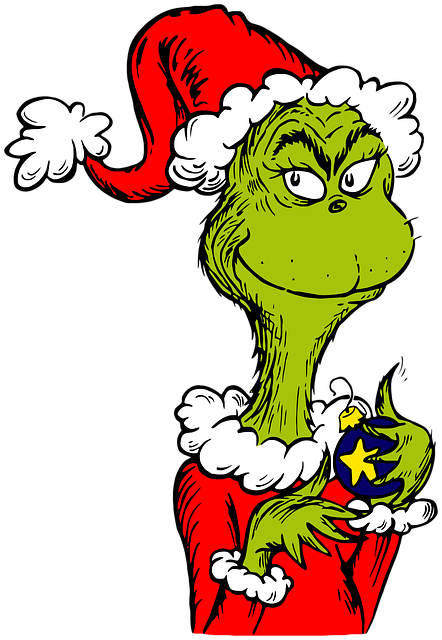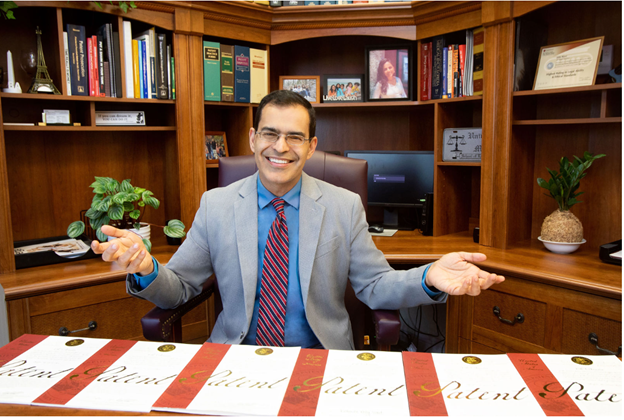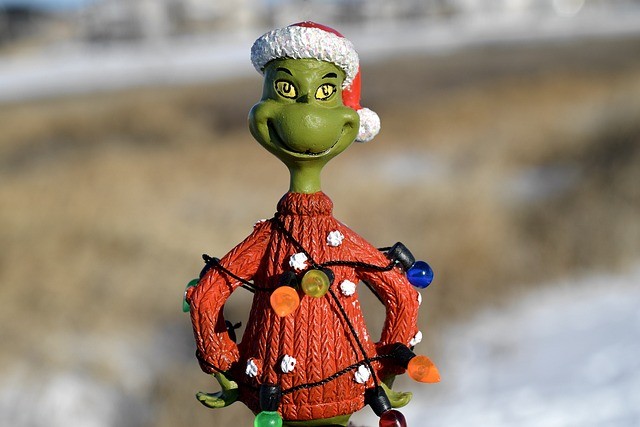Since Dr. Seuss (aka Theodore Geisel) first penned How the Grinch Stole Christmas in 1957, the green meanie with a hatred for holidays and Whos alike has become one of the most iconic antiheroes of the holiday season.
But the Grinch’s popularity means that a lot of people, including photographers, are trying to capitalize on including the puce-furred purloiner of presents in their bodies of work–and putting themselves in the legal sights of Dr. Seuss Enterprises, who owns most of the trademarks and copyrights associated with the grouchy gift grabber.
Has Dr. Seuss lost the plot and become the very character he lampooned, or are photographers and crafters really the ones who are trying to steal Christmas here?
Let’s see what the law has to say, and why the answer to this question has a lot of shutterbugs and family photo enthusiasts up in arms!
You’re a Mean One, Mr. Grinch…

The controversy started in 2019 with a seemingly simple idea from an Arkansas photographer, Kim Durham: Instead of the typical Yuletide pics with Santa Claus, reindeer, snowmen, and all the other usual suspects at this time of year, why not mix it up and have the Grinch come out to play? She recruited a teenager to dress up in full costume as the Grinch, took a bunch of pictures featuring young children doing everything from squealing with delight to crying in fear at the sight of the original Christmas canceller, and posted the results to her professional website. The images became a viral sensation which was covered by national news outlets including People, Today, and USWeekly, among others.
Unfortunately for Durham, this media attention quickly led to receiving a cease-and-desist letter from Dr. Seuss Enterprises.
The letter, which has taken on a viral life of its own, demanded that Durham immediately delete and destroy all digital and physical copies of the results of the shoot in her possession and on the internet as a whole; refrain from posting Grinch-themed pictures in future; cancel all scheduled Grinch-themed shoots; and promise to never again use the Grinch in any manner for professional purposes without obtaining prior permission from Seuss Enterprises. Durham complied (to the limits of her ability; remember, the internet is forever and once your information or content is out there, it’s out there for as long as an internet exists), and for her, at least, the matter was settled.
However, like Jacob Marley’s ghost, this story took on an afterlife all its own.

Every year, professional photographers post grim reminders to others to think twice before involving the Grinch in for-profit photo shoots. One Tennessee photographer, Brittany Kay, made a viral post of her own warning photographers that using the Grinch’s likeness “is federal trademark infringement, and Dr. Seuss Int. literally hires out a team this time of year to reverse image search and sue photogs for profit. So unless you got $120[,]000 for a license, that’s not a lawsuit you will win!”
It’s unclear where she came up with that precise figure to acquire a license, but the basic sentiment is one photographers and crafters alike would be wise to heed.
But the perennial question remains: Isn’t this, in and of itself, a Grinchy move by Dr. Seuss?
…But Then Again, You’re Just Protecting Yourself

The key point here is that people who have received C&Ds from Dr. Seuss Enterprises got them because they were using legally protected material for profit.
It’s not like whipping up your own riff on St. Nick or the Easter Bunny or the Tooth Fairy; these are all in the public domain, while the original Grinch is a registered trademark and covered under copyright law until January 1st, 2062, at the very earliest. (The subsequent versions, including the original movie starring Boris Karloff, the 2000 live-action remake with Jim Carrey, and the most recent animated version, won’t be in the public domain for 95 years from the date of registration under current copyright laws.)
Thinking of similar holiday icons, even creating a knock-off red-nosed reindeer the way the Grinch did with his loyal dog Max could get you in legal hot water. This is because Rudolf the Red-Nosed Reindeer is under copyright until January 1st, 2034!
Most people who question this point do so because they don’t understand how trademark and copyright laws work; what they do; why they do it; and what they require of those who hold trademarks and copyrights. So let’s dig into this point from an IP law perspective.
Copyright law is intended to protect original creations, such as art, music, and original writings. Trademark law is intended to prevent market dilution and brand confusion.
Both sets of laws have some exceptions for what is known as “fair use,” which means usages that are not considered to be infringement in the eyes of the law. These carve-outs include criticism, comment, news reporting, teaching, scholarship, and research. They usually also include satire and parody, although these latter points are typically lumped under the “criticism” heading. In addition, using copyrighted material commercially (whether for profit or not; yes, charities and nonprofits still need to secure permission and licenses to use copyrighted and/or trademarked material, even if they’re not actually making money on the usage) means the resulting product may be more susceptible to infringement claims than if it is used non-commercially.
But these are well-known factual points of law that people insist on arguing ad nauseum, no matter how many times they’re demonstrated to be incorrect. A more interesting, albeit irrelevant, point, rails against the changes in copyright law in the last 45 years which extended copyright from 28 years from registration, with an option to renew for 28 more, to the 95-year mark we recognize today. Opponents argue that the newer copyright laws should have been written only to apply to works produced subsequent to their passage and that other works should have remained under the old scheme. It’s interesting because there is some validity in this argument; it’s irrelevant because that’s not how the law was written or passed, and the text of the law as written is what we have to work with today.
It’s also important to note that in trademark and copyright law, the holder is required to defend their intellectual property against infringement and unauthorized use, using all legal mechanisms at their disposal. If you don’t use these protections, you could easily lose them–and the rights to your IP altogether.
This is why Dr. Seuss Enterprises isn’t actually being the Grinch here; they’re simply following their obligations of due diligence and defense of their IP under the law. While it’s tempting for laypeople to paint them as the antagonists here, Dr. Seuss Enterprises isn’t the bad guy. Nor, for that matter, is Dr. Seuss himself, who died in 1991.
Whatabouts and (So-Called) Workarounds

In researching this article, I came across some ideas that many people think constitute a workaround for infringement claims. They’re wrong, or at least not entirely correct, but I think they should be evaluated just for the sake of completeness here.
One, which I addressed earlier, was the question of whether nonprofits and charitable organizations need to secure licenses to use protected IP. The answer, of course, is YES, they do. Ronald McDonald House recently did a photo shoot including the Grinch, and I think it’s a pretty safe bet that they got proper licenses and authorization to do so before they proceeded with the shoot.
Another was the idea of purchasing a (Grinch, Cinderella, etc.) costume. After all, the reasoning goes, once you purchase the costume, you have in essence purchased a license to wear and use that costume as you see fit. Again, this is true ONLY insofar as you are not using it for commercial applications. You can absolutely buy and wear a Grinch costume every day of the year if that makes you happy (and your friends, family, and significant other are especially tolerant). You can do that in the privacy of your own home or walk down Main Street at noon on Tuesday. Go nuts with it!

However, you CANNOT call yourself “THE Grinch” or try to monetize or commercially exploit that usage in any way without risking legal action against you, including C&Ds and expensive lawsuits.
One frequently suggested workaround strategy which MAY have a chance of succeeding is to not include the Grinch directly, but instead EVOKE the Grinch and/or Whoville and/or his famous lair at the top of Mt. Crumpet. I say this “may” work because while specific characters and their associated imagery are covered under copyright and trademark, a general gloomy gray/brightly colored festive/whimsical setting would likely be considered too generic to be covered under applicable laws.
Again, you’d have to be careful not to mention the “G-word” or anything related to it directly, but if you were cagey enough about the execution, this could probably slip under the radar. Please note that I am NOT advising anyone to try this! I am merely advancing an observation that this COULD work, but if you try it for yourself, you do so entirely at your own risk and on your own recognizance.
The most obvious workaround is…not actually a workaround at all.
Just get the license!

Of course, just because you request a license, even assuming you can afford one, doesn’t guarantee that you’ll get one. The reason is simple: Even though Dr. Seuss Enterprises holds MOST of the trademarks and copyrights, they don’t hold them all. Universal Studios also owns several trademarks and copyrights related to the Grinch. This means that Dr. Seuss Enterprises may not be able to unilaterally grant a license for a specific use, or may even be prohibited from doing so!
You can ask, certainly, and if you can get the IP holders’ approval and can pay their price, you can use it all you like within the limits of the original request, without fear of getting a legalese-covered lump of coal in YOUR stocking this season. If you can’t…well, you’re probably better off just not going there at all.
The Bottom Line

If you take a cute family picture with Dad dressed up as the Grinch and post it to social media this holiday season, you’re probably in the clear. If you do a needlepoint craft featuring the Grinch and share it on Facebook or TikTok, you’re likely okay. Both of these would typically be considered “personal use” and not subject to copyright or trademark infringement, provided you’re not offering to sell prints or needlepoint kits based on your creation.
But if you’re a professional photographer, an Etsy craft seller, or a T-shirt maker and you want to use the Grinch in your offerings, you should either reach out and find out how you can secure a license to do so, or come up with a different holiday theme that won’t get you in hot water.
Because if you decide to risk it, you may well end up being the very Grinch who steals YOUR Christmas!
ABOUT JOHN RIZVI, ESQ.

John Rizvi is a Registered and Board Certified Patent Attorney, Adjunct Professor of Intellectual Property Law, best-selling author, and featured speaker on topics of interest to inventors and entrepreneurs (including TEDx).
His books include “Escaping the Gray” and “Think and Grow Rich for Inventors” and have won critical acclaim including an endorsement from Kevin Harrington, one of the original sharks on the hit TV show – Shark Tank, responsible for the successful launch of over 500 products resulting in more than $5 billion in sales worldwide. You can learn more about Professor Rizvi and his patent law practice at www.ThePatentProfessor.com
Follow John Rizvi on Social Media
YouTube: https://www.youtube.com/c/thepatentprofessor
Facebook: https://business.facebook.com/patentprofessor/
Twitter: https://twitter.com/ThePatentProf
Instagram: https://www.instagram.com/thepatentprofessor/



